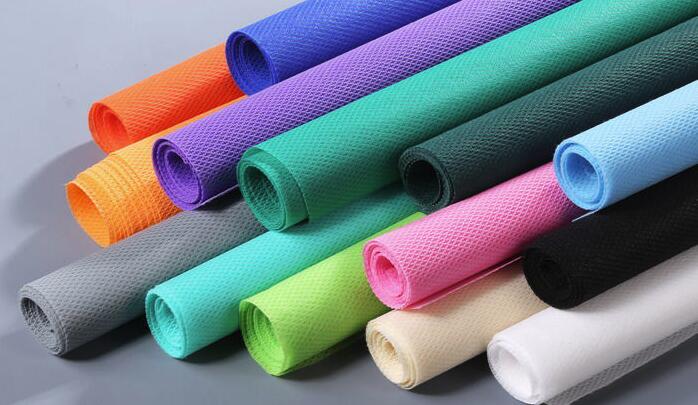Spunbond nonwoven is a non-toxic, harmless and environmentally friendly product. It is widely used, such as environmental protection bags, bedding linings, industrial processes, etc., with good anti-corrosion, acid and alkali resistance, anti-static, anti-bacterial and thermal insulation properties.

Spunbond nonwoven
In general, the basic process principle of the spunbonded nonwoven fabric is: slice drying → slice feeding → melt extrusion → spinning → cooling drafting → dividing wire laying → fiber mesh reinforcement. The following Lai Chi Xiaobian will give you a detailed introduction.
First, slice drying
The polymer chips obtained by dicing the cast strip usually contain a certain amount of water and must be removed by drying before spinning. For non-aqueous high polymer chips, such as polypropylene, etc., it is not necessary to dry.
The purpose of slice drying can be summarized into the following three points:
(1) Aqueous sections. For example, polyester chips are easily hydrolyzed during melting, which reduces the relative molecular mass and affects the quality of the filament.
(2) The water vaporizes at a high temperature, and can form a foaming filament, which is easy to cause a broken yarn or a filament.
(3) The water-containing polyester chip is an amorphous structure with low softening point, which is easy to soften and bond in the feeding section of the screw, which causes ring-shaped bonding and material blocking, which affects normal production.
Second, spinning
The spinning equipment and process used in the spunbond process are basically the same as those in the chemical fiber spinning. The main equipment and accessories are screw extruders and spinnerets.
Third, stretching
The newly formed melt-spun fiber (nasborn fiber) has low strength, large elongation, and extremely unstable structure, so it does not have the properties required for textile processing and must be stretched.
After stretching, the degree of orientation of the macromolecules in the low-order region of the nascent fibers along the axial direction of the fiber is increased, accompanied by other structural changes such as density and crystallinity. The improvement of the degree of orientation causes a significant increase in the breaking strength of the fiber, a decrease in the elongation at break, and an improvement in wear resistance and fatigue resistance.
The main methods of stretching the primary fibers are roller mechanical stretching and air stretching. In the production of spunbonded nonwoven fabrics, since spinning, drawing, laying, and consolidation are continuously performed, stretching is required to be completed in a very short period of time. The use of roller-type mechanical stretching has certain difficulties, and while stretching, it is also required to air-cool the fibers to prevent blocking. Therefore, in practical applications, air stretching or mechanical stretching is combined with air stretching to stretch, and individual roller mechanical stretching is used.
Fourth, the wire
The term "filing wire" means separating the stretched tow into a monofilament shape to prevent the fibers from sticking or sticking to each other during web formation. Commonly used wire separation methods are as follows:
Air separation method
2. Mechanical wire division method
3. Forced charging method
4. Friction charging method
Fifth, the network
The drawn and divided filaments must be evenly spread onto the web curtain. The key to the network is to control the movement of the filaments. There are two main control methods:
Air flow control
2. Mechanical control
Sixth, suction net
The suction airflow can be taken away by the suction net to control the rebound of the tow. To this end, a vertical guide air flow orifice plate of about 20 cm thickness is provided under the mesh curtain to prevent the reverse air flow from blowing the web. A pair of wind-shielding rolls are arranged at the suction boundary of the advancing direction of the web. The upper roll has a larger diameter and is relatively smooth, and a cleaning knife is provided to prevent the winding. The lower roll has a smaller diameter and is usually rubberized to hold the web and the web curtain. The auxiliary suction duct directly sucks in the airflow pressure net to control the web to be attached to the mesh curtain.
Seven, reinforcement
Reinforcement is the last process. The reinforcement gives the web a certain strength and elongation to meet the requirements of the product. There are mainly the following types of reinforcement.
Self-adhesive reinforcement
2. Thermal bonding reinforcement
3. Needle reinforcement
4. Composite reinforcement
Dongyang Laichi Environmental Protection Technology Co., Ltd. is a well-received nonwoven fabric manufacturer, specializing in production and sales: nonwoven fabrics, elastic non-woven fabrics, spunbond nonwoven fabrics, medical non-woven fabrics. Laiwu spunbond nonwoven fabric is light, soft, breathable, non-toxic and environmentally friendly, ensuring product quality, and it is necessary to let customers buy the peace of mind and peace of mind.
For more product information, please contact: Mr. Zhu 13706796423 Website: http://www.ritschelastic.com/En_index.html




